Abstract
OBJECTIVES. Elevated lead levels in calcium supplements may pose a health risk, particularly to children with milk intolerance who rely on these products to meet their calcium requirement. Earlier reports chiefly focused on the lead content in supplements derived from bonemeal and dolomite. This study undertook to determine the lead levels in the major forms of calcium supplements currently available. METHODS. The lead content was measured in 70 brands of calcium supplements grouped in the following five categories: dolomite, bonemeal, refined and natural source calcium carbonate, and calcium chelates. RESULTS. The lead levels measured in the supplements ranged from 0.03 microgram/g to 8.83 micrograms/g. Daily lead ingestion rates revealed that about 25% of the products exceeded the US Food and Drug Administration's "provisional" total tolerable daily intake of lead for children aged 6 years and under. Less than 20% of the supplements had "normalized" lead levels comparable to or lower than that reported for cow's milk. CONCLUSIONS. Children are the most sensitive to the low-level effects of lead. If calcium supplements are to provide an alternate source of calcium to some of these individuals, they should also deliver concomitant lead dosages no greater than those obtained from milk products themselves.
Full text
PDF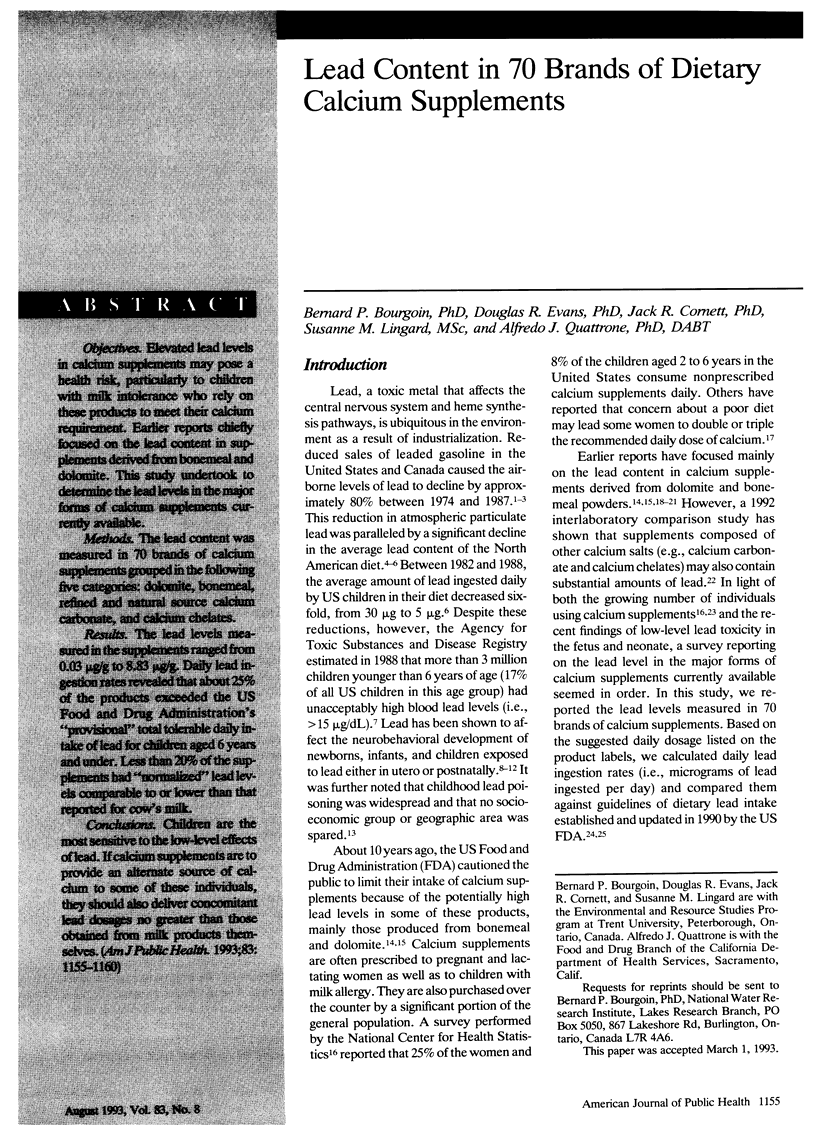
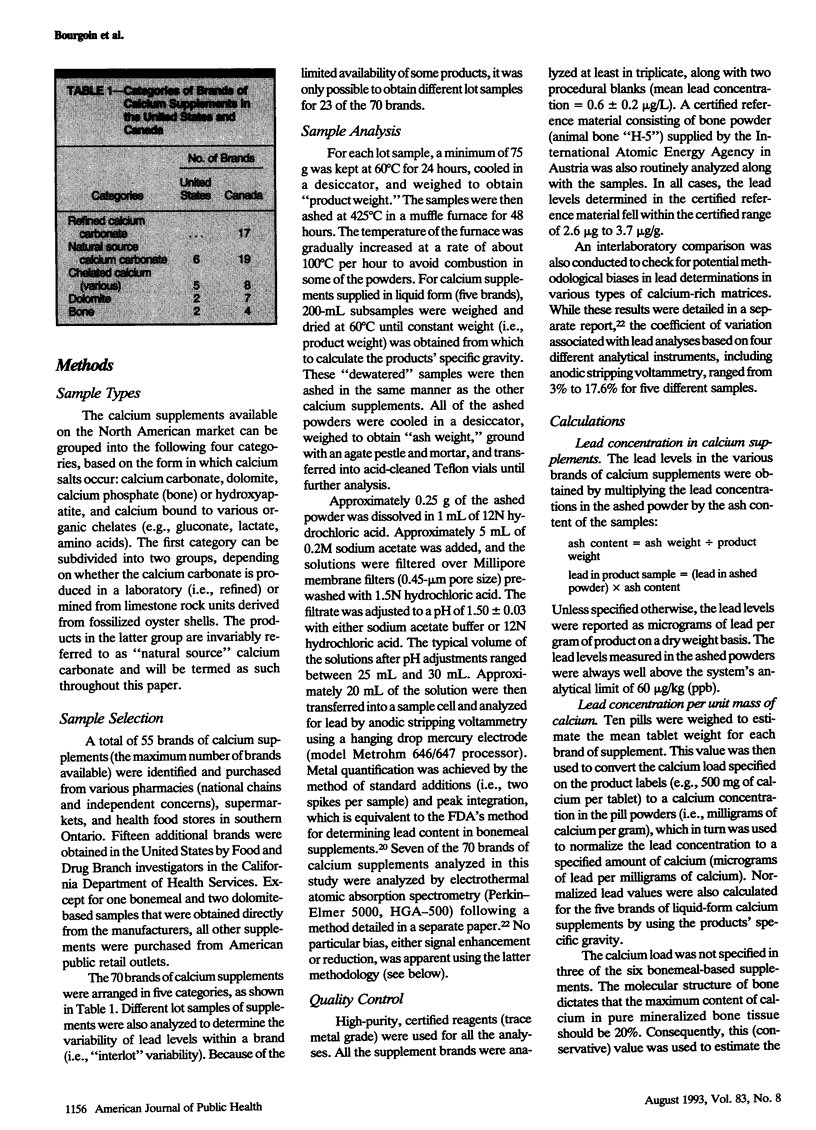
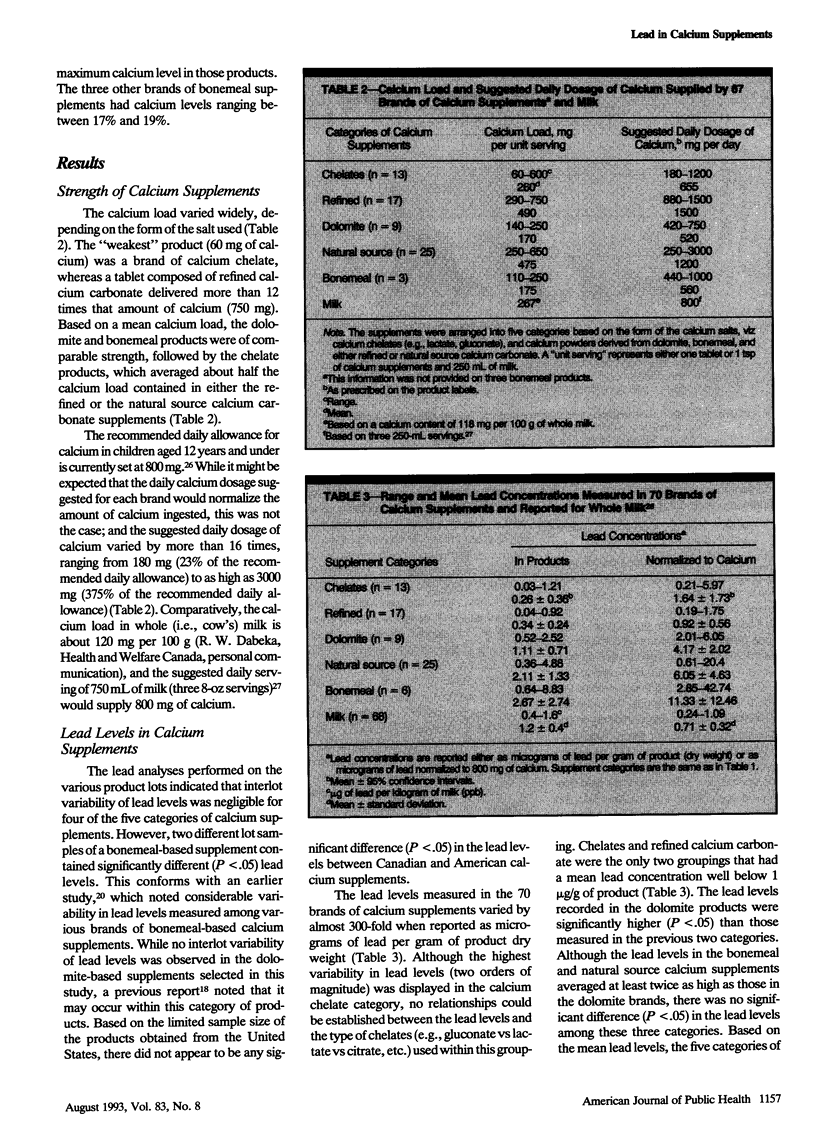

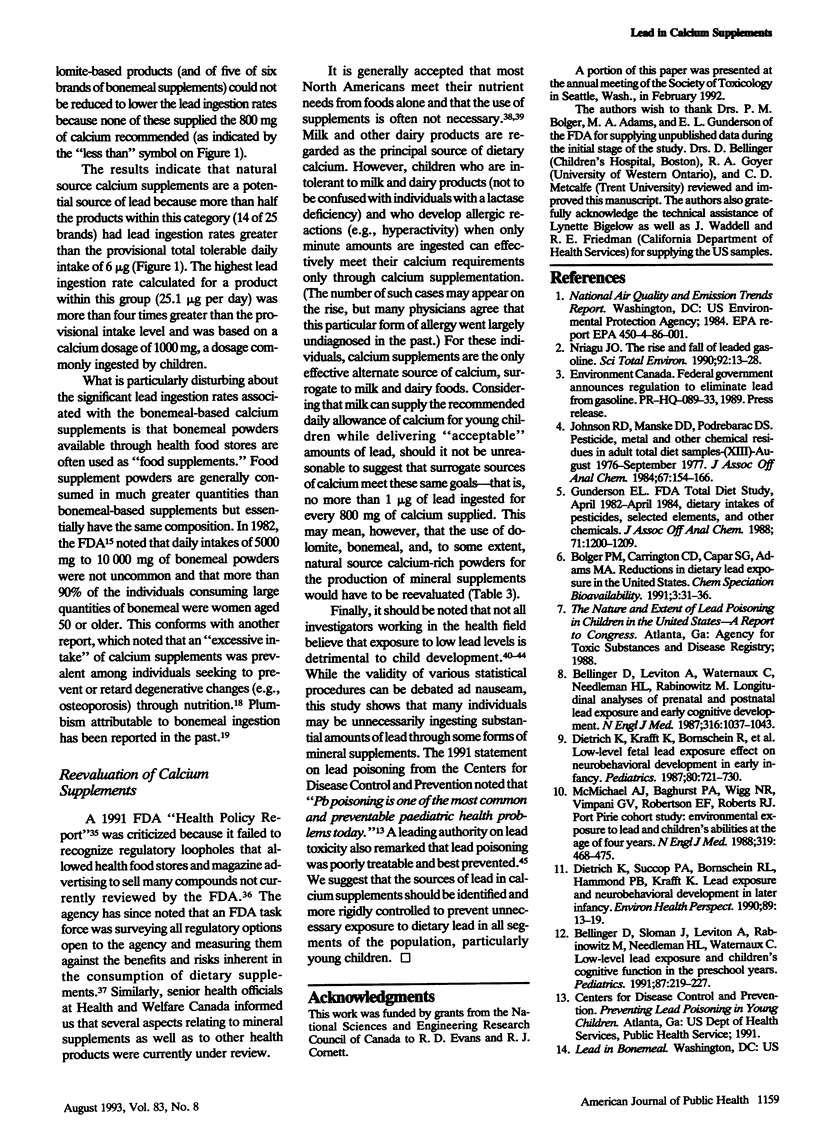
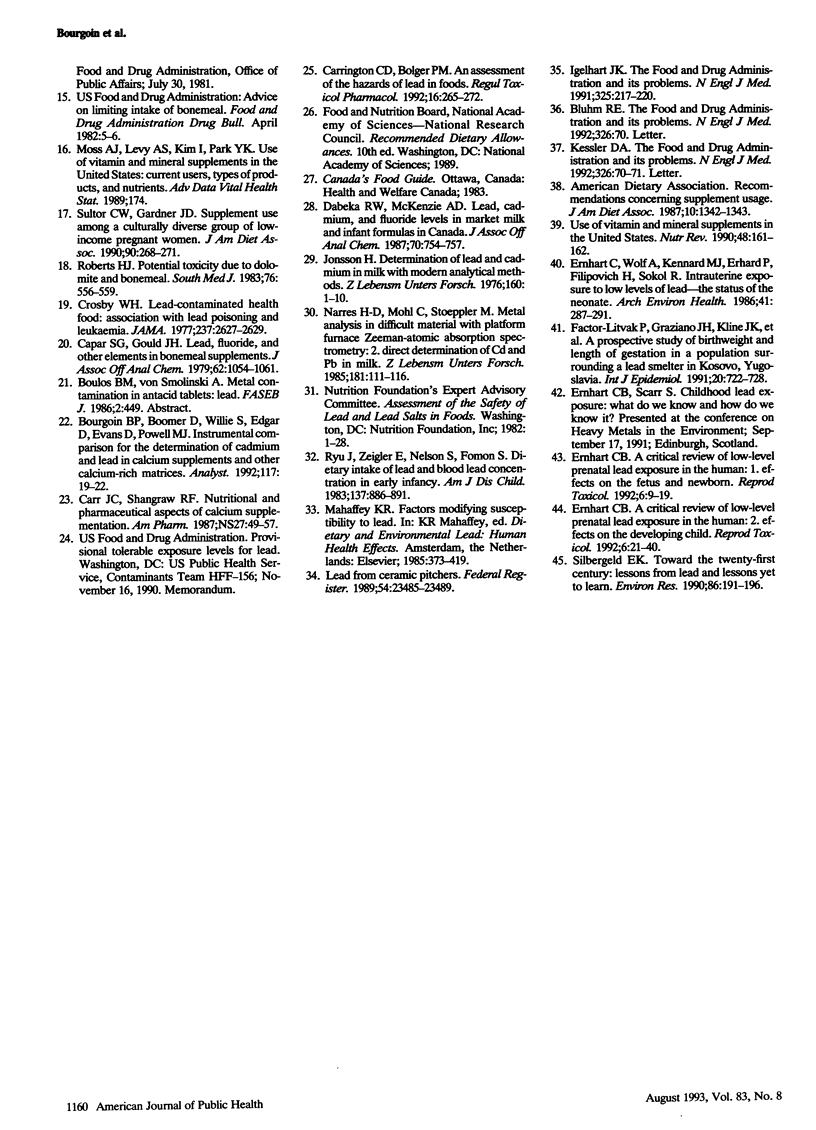
Selected References
These references are in PubMed. This may not be the complete list of references from this article.
- Bellinger D., Leviton A., Waternaux C., Needleman H., Rabinowitz M. Longitudinal analyses of prenatal and postnatal lead exposure and early cognitive development. N Engl J Med. 1987 Apr 23;316(17):1037–1043. doi: 10.1056/NEJM198704233161701. [DOI] [PubMed] [Google Scholar]
- Bellinger D., Sloman J., Leviton A., Rabinowitz M., Needleman H. L., Waternaux C. Low-level lead exposure and children's cognitive function in the preschool years. Pediatrics. 1991 Feb;87(2):219–227. [PubMed] [Google Scholar]
- Bourgoin B. P., Boomer D., Powell M. J., Willie S., Edgar D., Evans D. Instrumental comparison for the determination of cadmium and lead in calcium supplements and other calcium-rich matrices. Analyst. 1992 Jan;117(1):19–22. doi: 10.1039/an9921700019. [DOI] [PubMed] [Google Scholar]
- Capar S. G., Gould J. H. Lead, fluoride, and other elements in bonemeal supplements. J Assoc Off Anal Chem. 1979 Sep;62(5):1054–1061. [PubMed] [Google Scholar]
- Carr C. J., Shangraw R. F. Nutritional and pharmaceutical aspects of calcium supplementation. Am Pharm. 1987 Feb;NS27(2):49-50, 54-7. doi: 10.1016/s0160-3450(15)32077-8. [DOI] [PubMed] [Google Scholar]
- Carrington C. D., Bolger P. M. An assessment of the hazards of lead in food. Regul Toxicol Pharmacol. 1992 Dec;16(3):265–272. doi: 10.1016/0273-2300(92)90006-u. [DOI] [PubMed] [Google Scholar]
- Crosby W. H. Lead-contaminated health food. Association with lead poisoning and leukemia. JAMA. 1977 Jun 13;237(24):2627–2629. [PubMed] [Google Scholar]
- Dabeka R. W., McKenzie A. D. Lead, cadmium, and fluoride levels in market milk and infant formulas in Canada. J Assoc Off Anal Chem. 1987 Jul-Aug;70(4):754–757. [PubMed] [Google Scholar]
- Dietrich K. N., Krafft K. M., Bornschein R. L., Hammond P. B., Berger O., Succop P. A., Bier M. Low-level fetal lead exposure effect on neurobehavioral development in early infancy. Pediatrics. 1987 Nov;80(5):721–730. [PubMed] [Google Scholar]
- Dietrich K. N., Succop P. A., Bornschein R. L., Krafft K. M., Berger O., Hammond P. B., Buncher C. R. Lead exposure and neurobehavioral development in later infancy. Environ Health Perspect. 1990 Nov;89:13–19. doi: 10.1289/ehp.908913. [DOI] [PMC free article] [PubMed] [Google Scholar]
- Ernhart C. B. A critical review of low-level prenatal lead exposure in the human: 1. Effects on the fetus and newborn. Reprod Toxicol. 1992;6(1):9–19. doi: 10.1016/0890-6238(92)90017-n. [DOI] [PubMed] [Google Scholar]
- Ernhart C. B. A critical review of low-level prenatal lead exposure in the human: 2. Effects on the developing child. Reprod Toxicol. 1992;6(1):21–40. doi: 10.1016/0890-6238(92)90018-o. [DOI] [PubMed] [Google Scholar]
- Ernhart C. B., Wolf A. W., Kennard M. J., Erhard P., Filipovich H. F., Sokol R. J. Intrauterine exposure to low levels of lead: the status of the neonate. Arch Environ Health. 1986 Sep-Oct;41(5):287–291. doi: 10.1080/00039896.1986.9936698. [DOI] [PubMed] [Google Scholar]
- Factor-Litvak P., Graziano J. H., Kline J. K., Popovac D., Mehmeti A., Ahmedi G., Shrout P., Murphy M. J., Gashi E., Haxhiu R. A prospective study of birthweight and length of gestation in a population surrounding a lead smelter in Kosovo, Yugoslavia. Int J Epidemiol. 1991 Sep;20(3):722–728. doi: 10.1093/ije/20.3.722. [DOI] [PubMed] [Google Scholar]
- Gunderson E. L. FDA Total Diet Study, April 1982-April 1984, dietary intakes of pesticides, selected elements, and other chemicals. J Assoc Off Anal Chem. 1988 Nov-Dec;71(6):1200–1209. [PubMed] [Google Scholar]
- Iglehart J. K. The Food and Drug Administration and its problems. N Engl J Med. 1991 Jul 18;325(3):217–220. doi: 10.1056/NEJM199107183250322. [DOI] [PubMed] [Google Scholar]
- Johnson R. D., Manske D. D., New D. H., Podrebarac D. S. Pesticide, metal, and other chemical residues in adult total diet samples. (XIII). August 1976-September 1977. J Assoc Off Anal Chem. 1984 Jan-Feb;67(1):154–166. [PubMed] [Google Scholar]
- Jönsson H. Determination of lead and cadmium in milk with modern analytical methods. Z Lebensm Unters Forsch. 1976 Jan 30;160(1):1–10. doi: 10.1007/BF01252667. [DOI] [PubMed] [Google Scholar]
- McMichael A. J., Baghurst P. A., Wigg N. R., Vimpani G. V., Robertson E. F., Roberts R. J. Port Pirie Cohort Study: environmental exposure to lead and children's abilities at the age of four years. N Engl J Med. 1988 Aug 25;319(8):468–475. doi: 10.1056/NEJM198808253190803. [DOI] [PubMed] [Google Scholar]
- Narres H. D., Mohl C., Stoeppler M. Metal analysis in difficult materials with platform furnace Zeeman-atomic absorption spectroscopy. 2. Direct determination of cadmium and lead in milk. Z Lebensm Unters Forsch. 1985 Aug;181(2):111–116. doi: 10.1007/BF01042571. [DOI] [PubMed] [Google Scholar]
- Roberts H. J. Potential toxicity due to dolomite and bonemeal. South Med J. 1983 May;76(5):556–559. doi: 10.1097/00007611-198305000-00005. [DOI] [PubMed] [Google Scholar]
- Rye J. E., Ziegler E. E., Nelson S. E., Fomon S. J. Dietary intake of lead and blood lead concentration in early infancy. Am J Dis Child. 1983 Sep;137(9):886–891. [PubMed] [Google Scholar]
- Silbergeld E. K. Toward the twenty-first century: lessons from lead and lessons yet to learn. Environ Health Perspect. 1990 Jun;86:191–196. doi: 10.1289/ehp.9086191. [DOI] [PMC free article] [PubMed] [Google Scholar]
- Suitor C. W., Gardner J. D. Supplement use among a culturally diverse group of low-income pregnant women. J Am Diet Assoc. 1990 Feb;90(2):268–271. [PubMed] [Google Scholar]


